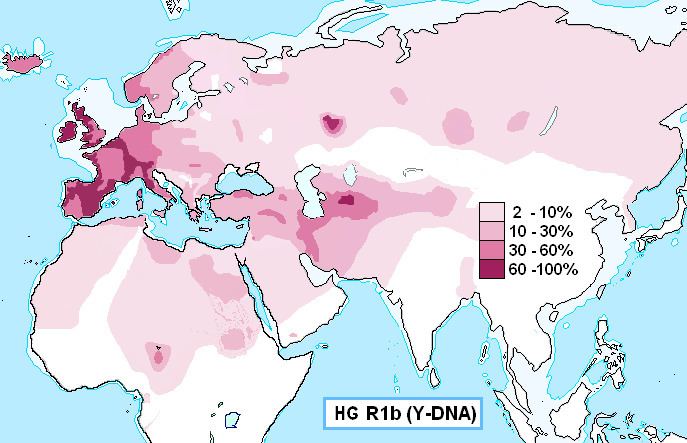 | ||
Genetic studies on Serbs show close affinity to the neighbouring peoples of the Balkans, especially to other South Slavs.
Contents
2005 studies
The haplogroup nomenclature follows the YCC 2008 system. See Conversion table for Y chromosome haplogroups for comparison with the nomenclature used in pre-2008 sources.
Y-chromosomal haplogroups identified among the Serbs from Serbia and Bosnia-Herzegovina are the following:
There are also several other uncommon haplogroups with lesser frequencies.
Y-chromosomal haplogroups identified among the Serbs from Serbia and Bosnia-Herzegovina are the following: I2a-P37.2 (with frequencies of 29.20 and 30.90%, respectively), E1b1b1a2-V13 (20.35 and 19.80%), R1a1-M17 (15.93 and 13.60%), R1b1b2-M269 (10.62 and 6.20%), K*-M9 (7.08 and 7.40%), J2b-M102 (4.40 and 6.20%), I1-M253 (5.31 and 2.5%), F*-M89 (4.9%, only in B-H), J2a1b1-M92 (2.70%, only in Serbia), and several other uncommon haplogroups with lesser frequencies.
I2a-P37.2 is the most prevailing haplogroup, accounting for nearly one-third of Serbian Y-chromosomes. Its frequency peaks in Herzegovina (64%), and its variance peaks over a large geographic area covering B-H, Serbia, Hungary, Poland, the Czech Republic, and Slovakia. Geneticists estimate that I2a-P37.2 originated some 10,000 years before present (ybp) in the Balkans, from where it began to expand to Central, Eastern, and Southeastern Europe about 7000 ybp. It is the second most predominant Y-chromosomal haplogroup in the overall Slavic gene pool. Slavic migrations to the Balkans in the early Middle Ages contributed to the frequency and variance of I2a-P37.2 in the region.
E1b1b1a2-V13 is the second most prevailing haplogroup, accounting for one-fifth of Serbian Y chromosomes. In Southeast Europe, its frequency peaks at the southeastern edge of the region and its variance peaks in the region's southwest. Although its frequency is very high in Kosovo Albanians (46%) and Macedonian Romani (30%), this phenomenon is of a focal rather than a clinal nature, most likely being a consequence of genetic drift. This haplogroup is also high among Albanians in Macedonia (34%) and Albania (24%), as well as Macedonian Slavs, and Greeks. It is rare among other Slavs, and moderate frequencies of it are found in southern Italy and Anatolia. E-V13 probably originated in the southern Balkans about 9000 ybp. Its ancestral haplogroup, E1b1b1a-M78, could be of a northeast African origin.
R1a1-M17 accounts for about one-seventh to one-sixth of Serbian Y-chromosomes. Its frequency peaks in Poland (56.4%) and Ukraine (54.0%), and its variance peaks in northern Bosnia. It is the most predominant haplogroup in the general Slavic paternal gene pool. The variance of R1a1 in the Balkans might have been enhanced by infiltrations of Indo-European speaking peoples between 2000 and 1000 BC, and by the Slavic migrations to the region in the early Middle Ages. A descendant lineage of R1a1-M17, R1a1a7-M458, which has the highest frequency in Poland, Slovakia, and the Czech Republic but it is rare among South Slavs, including Serbs.
R1b1b2-M269 is moderately represented among the Serb males (6–10%). It has its frequency peak in Western Europe (90% in Wales), but a high frequency is also found in the Caucasus among the Ossetians (43%). It was introduced to Europe by farmers migrating from western Anatolia, probably about 7500 ybp. Serb bearers of this haplogroup are in the same cluster as Central and East European ones, as indicated by the frequency distributions of its sub-haplogroups with respect to total R-M269. The other two clusters comprise, respectively, West Europeans and a group of populations from Greece, Turkey, the Caucasus and the Circum-Uralic region.
J2b-M102 and J2a1b1-M92 have low frequencies among the Serbs (6–7% combined). Various other lineages of haplogroup J2-M172 are found throughout the Balkans, all with low frequencies. Haplogroup J and all its descendants originated in the Middle East. It is proposed that the Balkan Mesolithic foragers, bearers of I-P37.2 and E-V13, adopted farming from the initial J2 agriculturalists who colonized the region about 7000 to 8000 ybp, transmitting the Neolithic cultural package.
An analysis of molecular variance based on Y-chromosomal STRs showed that Slavs can be divided into two groups: one encompassing West Slavs, East Slavs, Slovenes, and western Croats, and the other encompassing Bulgarians, Macedonian Slavs, Serbs, Bosniaks, and southern Croats. This distinction could be explained by a genetic contribution of pre-Slavic Balkan populations to the genetic heritage of South Slavs belonging to the group. Principal component analysis of Y-chromosomal haplogroup frequencies among the three ethnic groups in Bosnia and Herzegovina, Serbs, Croats, and Bosniacs, showed that Serbs and Bosniacs are genetically closer to each other than either of them is to Croats.
2012 studies
A total of 103 Serbian individuals were sampled in 2012, and the majority of Serbian Y-chromosomes (58%) belonged to pre-Neolithic lineages.
Physical anthropology
According to Serbian physical anthropologist Živko Mikić, the medieval population of Serbia developed a phenotype that represented a mixture of Slavic and indigenous Balkan Dinaric traits. Mikić argues that the Dinaric traits, such as brachycephaly and a bigger average height, have been since then becoming predominant over the Slavic traits among Serbs.
